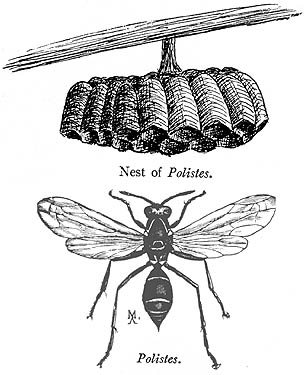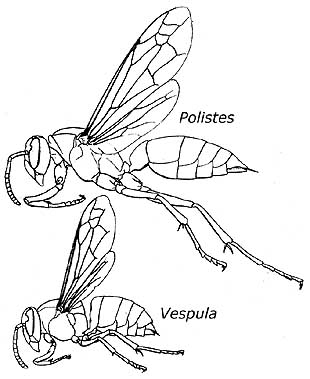BUG OF THE MONTH: September 1995
Polistes fuscatus, Paper Wasp
Order Hymenoptera, family Vespidae
Copyright © 1995 by Louise Kulzer
This article originally appeared in Scarabogram, September 1995, New Series No. 185, pp. 3-4.

Paper wasps fly from early spring to late fall. They are in the yellowjacket family, Vespidae. However, they have a separate subfamily from the yellowjackets (according to Akre, 1981, there is a third subfamily from southeast Asia; we'll just ignore them, OK?). All paper wasps are beneficial. They prey on soft-bodied insects, especially caterpillars. They are not at all bothersome, being uninterested in people or in scavenging for food, unlike some of their yellowjacket cousins.
Actually, adult paper wasps don't eat caterpillars, they eat nectar. So what do they do with the caterpillars? Well, paper wasps make nests of cellulose fiber (paper) to brood their young. (Remember, the larvae of wasps are grubs). To grow in the nest cell, the grub needs food - and that's where the caterpillars come in. The adult wasp paralyzes the caterpillar with its sting and stuffs it into the nest cell and lays an egg in the cell. The egg hatches, finding ample food to grow to full grub size. Then the grub enters the pupal, or resting stage, wherein its body stuff is rearranged, and it emerges as an adult winged wasp.
The early broods become worker wasps, gathering nectar, hunting caterpillars and other suitable food, and gathering cellulose to expand the nest. Later in the season, the last broods of grubs turn into reproductive adults which mate and overwinter to establish a nest next season.

But how do you know if it's a yellowjacket or a paper wasp? Picture a yellowjacket (black & yellow, striped abdomen, drill-like buzz...). Paper wasps are a bit bigger with proportionately longer reddish legs. They're more gangling - kind of like a basketball player as opposed to a footfall player (see sketches). Like all vespid wasps, paper wasps have wings which fold longitudinally and are held along the sides of their body, not flat over the back like honey bees.
Another good way to tell wasps is to follow an individual to its nest. Paper wasp nests are typically small, attached by a stalk to an overhanging support, and have a single comb of cells. There is no paper envelope like yellowjackets, so the individual cells are readily visible. Usually the stalk is attached in the middle, resulting in the nest hanging parallel to the ground. Most of the time, paper wasps hang their nests from manmade structures, but trees and shrubs are used too (Reed & Vinson 1979).
Paper wasps have a special liking for umbelliferous plants. Having chewing mouthparts, they are not able to reach far for nectar, as bees can. Umbels have shallow nectaries, and make suitable fast food stops. Dill and fennel are especially good, but parsley, parsnip or carrot gone to seed are useful too. So do yourself a favor this fall - let some umbels flower, and be prepared for the gangling paper wasps to grace your garden.
References:
Akre, R.D., A.Greene, J.P.MacDonald, P.J.Landolt, and H.G. Davis. 1981. The yellowjackets of America North of Mexico. U.S. Department of Agriculture, Agriculture Handbook 552, 102 pp.
Reed, Hal, and S. Vinson. 1979. Nesting ecology of paper wasps (Polistes) in a Texas urban area (Hymenoptera: Vespidae). Journal of the Kansas Entomological Society, 52(4): 673-689.
This page last updated 16 June, 2005